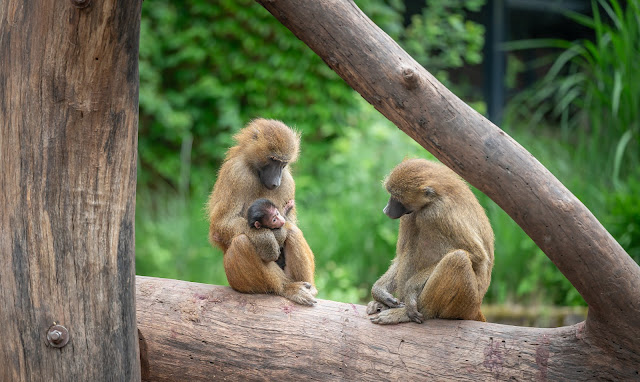Nikkor 70-180 f/2.8 - A Review
 |
| f/2.8 180mm 1/250 ISO900 |
This is one of the many alternatives in the middle telephoto range for Nikon Z. We have now: 24-120, 24-200, 70-200, 70-300, 100-400, and the 105. The 70-180 is not as wide as the superzooms, nor as long as the expensive telephoto lenses. But it is faster than the 24-200, lighter and more affordable than the 70-200, and sharper than the Tamron 70-300. So, it is clearly a lens to consider.
The image above and the one below shows the benefits of a faster lens. Not only do you get a nice isolation of the subject, but you can also restrict yourself to lower ISO numbers, even with a fast shutter speed. I do not buy the new dogma, that ISO does no longer matter. Fine natural details are only possible with lower ISO. The current software for noise reduction does often wonders, but less noise to begin with is better.
 |
| f/2.8 170mm 1/160 ISO1100 |
For the lions on this page and all other zoo images, I used mode M with a shutter speed high enough to prevent any motion blur or camera shake while still providing ISO below my personal limit 1600. However, some animals are fast and need even more speed. Only with enough light you can still avoid higher ISO.
 |
| f/2.8 1/1600 180mm (~220mm crop) ISO250 |
Some ISO numbers on this page and other pages are misleading. The following image was lightened up quite a lot, and consequently, the true ISO may be closer to ISO1600. I used Lightrooms default noise reduction to get a smooth look without smearing too much over details.
The picture is also heavily cropped. Unfortunately, I was not fast enough to adjust the focal length when the animal appeared. Thus I had to crop from 100mm to almost 280mm.
 |
| f/2.8 1/400 101mm (~280mm crop) ISO500 |
The lens is not a wildlife lens. For this, you need more like 200-600mm, and cropping nevertheless. But for the zoo and other occasions, it is very capable of delivering satisfying results. You should not be afraid of cropping, however. The one above is reduced to about 10MP. But I would still print it at medium sizes.
The lens works with the 2x teleconverter. The test at Photography Life says that there is a lot of reduction in image resolution. The results should be better than cropping, but I cannot verify this.
 |
| f/5.6 1/3200 150mm (~230mm crop) ISO100 |
Contrast and sharpness of this lens are on a very high level as well as chromatic issues or flares. I would call it an excellent lens. I am very confident you will like the quality of this lens.
The Nikkor 70-200 f/2.8 is better, but way more expensive and bulky. If you are into wildlife photography, it is still too short, but it is a professional continuation of the 24-70 f/2.8. For amateurs with a restricted budget, both are overkill.
 |
| f/16 1/100 88mm ISO560 |
There are several use cases for this lens.
- Landscape photography showing details in the distance in a compressed way. Be aware that even at 70mm the DOF is limited and take a higher f-stop is needed.
- Portrait photography showing head, upper body or full body. I recommend f/4 for enough DOF. For a beauty shot f/2.8, 135mm or above and enough distance to the subject work very efficiently.
- Wildlife photography for animals that are close enough. Be sure to use a fast shutter speed.
- Micro to macro photography. Use the long end of the lens. It can focus surprisingly close. And do not be afraid to crop.
 |
| f/5.6 180mm (~360mm crop) ISO1600 |
But even for medium sized flowers, this lens does a wonderful job. For a smooth background, it is much preferable to take a longer lens and a closer aperture than a normal lens and an open aperture. You will get more depth of field. In fact, the same aperture produces almost the same depth on different focal lengths for a frame filling subject. You need to step back with a longer lens, of course, but you get much more creamy backgrounds.
 |
| f/8 170mm 1/200 ISO280 |
You may wonder about the focus speed and accuracy. I have nothing bad to report here. The focus speed with this fast lens is very good, much better than with the 24-200 or other slower lenses. Accuracy was high.
My problem is that I have only a Nikon Z5 which does not a good job with eyes of animals, maybe besides cats. It does also not track as good as the higher Z cameras.
I thus prefer dynamic range AF continuous with back button focus. You can then release AF-ON to fix the focus for recomposing if you set shutter priority to "release" for AF-C. That worked good enough unless the animal is moving. Since I cropped most images anyway, I usually do not even have to recompose or reposition the dynamic range.
 |
| f/2.8 180mm (~220mm crop) 1/250 ISO400 |
In summary, there are clearly better lenses, but not with this price, weight and size. I am glad I went for the combination of the affordable and compact 24-70 f/4 and this one. I recommend it for anyone who needs a telephoto lens for landscape, closer wildlife or portrait without breaking the bank.
 |
| f/4 180mm (~320mm crop) 1/250 ISO800 |
Comments
Post a Comment